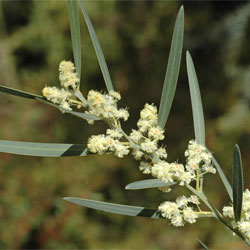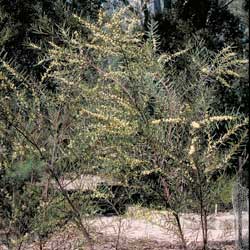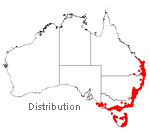Acacia suaveolens
 |
 |
Sweet Wattle
Acacia suaveolens (Sm.) Willd. (1806)
Acacia suaveolens was first described as Mimosa suaveolens by renowned botanist J.E. Smith, the founder of London’s Linneaen Society. He never visited Australia and described the plant from one grown from seed in the Sion gardens in Waterford, Ireland.
 Sweet scented wattle (A. suaveolens) draws it name from the small clumps of flowers that occur during winter and early spring. In its native habitat it is one of the earliest flowering of the wattles. It is common in the bushland surrounding Sydney and occurs from southern Queensland down the east coast into Tasmania. It also has populations on several off shore islands, the Grampians and in the border region of South Australia and Victoria. It inhabits coastal areas of low altitude ranging from secondary dunes up to an altitude of 300m. Populations have also been documented in the Budawang ranges and the Blue Mountains, west of Sydney.
Sweet scented wattle (A. suaveolens) draws it name from the small clumps of flowers that occur during winter and early spring. In its native habitat it is one of the earliest flowering of the wattles. It is common in the bushland surrounding Sydney and occurs from southern Queensland down the east coast into Tasmania. It also has populations on several off shore islands, the Grampians and in the border region of South Australia and Victoria. It inhabits coastal areas of low altitude ranging from secondary dunes up to an altitude of 300m. Populations have also been documented in the Budawang ranges and the Blue Mountains, west of Sydney.
A. suaveolens has bi-pinnate leaves only in very juvenile specimens. Phyllodes (modified leaf stalks) rapidly develop as the plant matures. The phyllodes are without hairs (glabrous) and are usually covered in fine white powder (glaucous). Like many other acacias it has a comparatively short life span with shrubs rarely living longer than 15 years. Flowering will usually occur 2 years after germination. The flowers are usually in groups of between 6 and 10. These flowers and seed pods provide a food source for a variety of birds and invertebrates.
Seeds are comparatively easy to germinate simply by soaking in boiling water for approx hour. Seed scarification with sand paper has also proved successful. In a horticultural sense it is very useful mainly due to its size. Other acacias regularly planted in gardens such as A. baileyana and A. longifolia can become large trees which will over time crowd out many smaller plants. A. suaveolens reaches a maximum height of around 3m. Highly variability in both foliage and growth patterns led to the naming of several subspecies in the past though these have been largely discounted. For detailed listing of synonyms see What’s Its Name at http://www.anbg.gov.au/win/index.html.
Maintenance of established trees is comparatively easy. Selective pruning can encourage more vigorous leaf growth. Growing in its natural habitat on coastal areas it is also mildly salt tolerant though not as much as A. longifolia. In its natural habitat it is killed by fire and therefore relies on stored seed reserves in the soil. A. suaveolens ideally grows in well drained coastal soils but also grows on deeper/heavier soils such as those of parts of Ku-ring-gai Chase National Park. It is also frost tolerant down to temperatures of -7.
Text by Emrys Leitch (2006 Botanical Intern)
Name Meaning: Acacia suaveolensAcacia - may be from a Greek word meaning to sharpen, referring to the prickly nature of the first species discovered; another opinion refers to the Egyptian thorn (akakia), a species of Acacia which yields gum arabic; suaveolens – sweet smelling, refers to the sweet smell produced by the flowers. |
References
Warton, David I., Wardle, Glenda. 2003. Site-to-site variation in the demography of a fire-affected perennial, Acacia suaveolens, at Ku-ring-gai Chase National park, New South Wales, Australia. Austral Ecology 28:38-47
Auld, Tony D., 1986. Dormancy and viability in Acacia suaveolens (Sm) Willd., Australian Journal of Botany. 34:463-72.
Auld, Tony D., & Myerscough, P.J. 1986. Population dynamics of the scrub Acacia suaveolens (Sm) Willd.: Seed production and predispersal seed predation, Australian Journal of Ecology 11(3):219-234
Auld, Tony D., 1986. Population dynamics of the scrub Acacia suaveolens (Sm) Willd.: Dispersal and the dynamics of the soil seed-bank
Morrison, David A.& Rupp, Jonas., 1995. Patterns of morphological variation within Acacia suaveolens (Mimosaceae). Australian Systematic Botany8:1012-1027.
Tame, Terry, 2002. Acacias of southeast Australia. Kangaroo press, Kenthurst N.S.W.
Flora of Australia, vol 11a. Mimosaceae, Acacia part 1. eds, Orchard, A.E., Wilson, Annette. C.S.I.R.O. publishing, Collingwood, Victoria
Stuart Donaldson - pers. com. (Australian National Botanic Gardens)
http://www.ireland.ie/things_2_do_results_single.asp?sID=45325 © Failte Ireland 2005
http://www.semencesdupuy.com/2F20-Acacia-Suaveolens.html © Les Semences du Puy 2003-2005
http://users.bigpond.net.au/folcnp/flowering/acacia%20suaveolens%20.htm © Friends of Lane Cove National Park 2006
http://users.bigpond.net.au/filejest/aca_suav.htm © Capricornica Publications Natural History Books
http://davesgarden.com/pf/go/59238/index.html© StandardOut, Inc. 2000-2006
http://www.australiaplants.com/Acacia_suaveolens.htm © 2003 Windmill Outback Nursery
http://www.organicmatters.com.au/acacia-suaveo.htm © Organic Matters 2006
![An Australian Government Initiative [logo]](/images/austgovt_brown_90px.gif)

